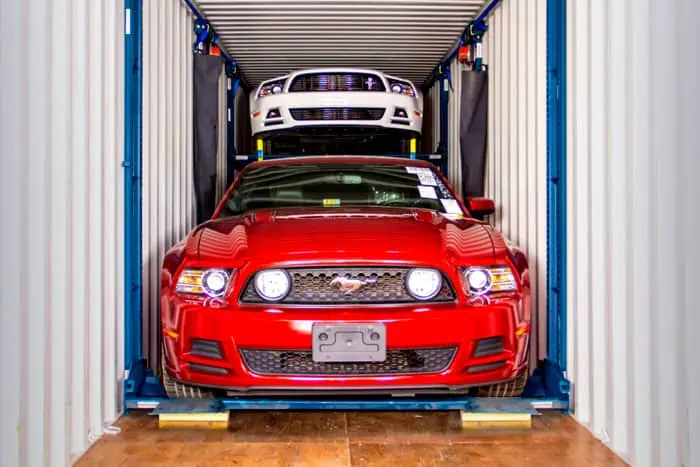When it comes to shipping a car overseas, one of the first things that you…

What Car Import Documents Do You Need?
Importing a car isn’t as simple as arranging shipping, then picking your vehicle up at the port. You will need to get all of the correct paperwork in place first. Whether you are importing your daily-use vehicle, or a classic or rare import, knowing what documents you need will keep the import process running as smoothly as possible.
In this article, we highlight the must-have documents that you will need and key considerations to keep in mind before starting the import process.
What Are the Key Documents Required for Importing Motor Vehicles?
When you are importing a vehicle into another country, there are certain documents that you will need to provide in order to satisfy Customs and Border Protection, as well as other authorities. These documents help to prove your ownership of the vehicle, confirm your vehicle’s eligibility, and show that the vehicle complies with local safety and emissions standards.
Before gathering your documents, it’s crucial to have accurate information about your vehicle’s manufacture, including the make, model, and year. This information is key because customs uses it to verify your vehicle’s origin and determine if it meets the necessary safety and environmental regulations. You will also need to check if your vehicle’s dutiable, meaning whether it’s subject to import taxes or duties.
Here is a summary of the key documents that you will be expected to provide:
- Proof of Vehicle Ownership: This should include your Original Title, Bill of Sale, and Foreign Registration document showing that you own the vehicle that you are importing.
- Valid Personal Identification Documents: You will need a valid government-issued photo ID or passport to verify your identity during the import process. This helps customs to ensure that the person importing the vehicle matches the ownership records.
- Bill of Lading: This is issued by the shipping company and confirms the shipping of your vehicle. If you are transporting any personal belongings inside the vehicle, remember to declare these as separate shipments.
- Customs Entry Form: In the US, this refers to the Customs and Border Protection (CBP) Form 7501, which officially declares your vehicle’s importation and determines if your vehicle is dutiable. This form is essential for calculating any import taxes or fees you owe and can be obtained from a CBP officer when your vehicle arrives at its port of entry.
- EPA Form 3520-1 and DOT Form HS-7: These forms declare that your vehicle meets US Environmental Protection Agency (EPA) emission regulations and Department of Transportation (DOT) safety standards, which include Federal Motor Vehicle Safety Standards (FMVSS), such as bumper standards.
These forms also state whether your vehicle qualifies for any EPA exemptions or exclusions. Vehicles compliant with these rules usually have a manufacturer’s certification label affixed to them. - Proof of Compliance or Eligibility: If your vehicle lacks the required manufacturer’s certification label, customs officials may require additional documents which prove that your car qualifies for import under EPA exemptions or exclusions.
- Tax and VAT Paperwork: You will need to provide proof that you have paid any applicable import taxes, customs duties, or VAT before your vehicle can be cleared for import.
- ICI Documentation: If your vehicle doesn’t meet EPA emission standards and it is not eligible for exemption, it must be imported via an Independent Commercial Importer (ICI). The ICI will handle any necessary modifications to ensure the vehicle complies with EPA and DOT standards before it can be released.
Special Considerations for European Cars and Similar Models
When importing European cars or vehicles that share the same model as US versions but are manufactured abroad, it’s crucial to verify if your vehicle meets all US safety and emissions standards. Even minor differences in manufacturing can affect eligibility. Checking the National Highway Traffic Safety Administration (NHTSA) website with a keyword search of your vehicle’s details can clarify if it’s dutiable or if it needs further modifications.
Understanding Nonconforming Vehicles and Import Regulations
Not every vehicle that is imported will automatically meet the EPA and DOT standards that are required for vehicles to be driven in the US. These so-called ‘nonconforming vehicles’ imported into the US may need modification before they can be legally driven on American roads.
A vehicle is classed as nonconforming if it was not originally manufactured to comply with EPA and DOT standards and it does not have a certification label affixed, usually on the driver’s side door or in the engine compartment (or near the steering post and handlebars on motorcycles). When you import nonconforming vehicles, you must follow special rules to bring them into compliance before they are considered to be road-legal.
If your vehicle is nonconforming, it can only be legally imported through a Registered Importer (RI). These specialists are authorized by the NHTSA to make the necessary modifications so that your car meets all of the required FMVSS and emissions requirements. Importers of nonconforming vehicles will also need to file a DOT bond, which serves as a financial guarantee that the vehicle will be brought into compliance within the required timeframe.
Once the RI finishes the modification work, they will ensure that a valid certification label is permanently affixed to your vehicle, proving it now complies with US regulations and is eligible to be registered.
What Is the 25-Year Rule and Why Does it Matter?
The 25-Year Rule is a specific rule that lets you import vehicles into the US that are at least 25 years old, without having to meet the usual DOT and EPA standards. This means that classic cars, rare imports, or any vehicle whose age hits that key milestone can be imported into the country without some of these tough compliance regulations. It is particularly important for older vehicles with historical value or technological significance that can’t be easily modified to meet these strict requirements.
This means that, for vehicles qualifying under the 25-year rule, you will need to provide fewer compliance-related documents, making the import process simpler.
What Is a Gray Market Vehicle and What Specific Documents Are Needed For Importing One?
Gray market vehicles are vehicles that were not originally manufactured for sale in their intended destination country. Instead, the car is being imported into that country through channels other than those officially authorized by the original manufacturer. These vehicles often do not meet the local environmental and safety standards or may lack the usual certification labels required for direct importation. Because of this, importing gray market cars can be more challenging and usually involves extra paperwork and inspections.
If you are looking to import a gray market vehicle, you will likely need to provide the following additional paperwork, as well as the key import documents mentioned above:
- Specific compliance paperwork which shows exactly how the vehicle meets or will meet the required local environmental and safety regulations
- Evidence of modifications or certification from an ICI or RI
- Detailed inspection reports
- Any extra documents that are required specifically by your destination country for non-standard imports
Working with a shipping company that has experience in handling gray market vehicles can make this complex process a lot smoother.
Importing Vehicles for Personal Use vs. Commercial Use
When it comes to automotive imports, the paperwork required can differ depending on whether you are importing a vehicle for your own personal use or for commercial purposes. Understanding these differences helps you to prepare the right documentation and avoid any unnecessary hassle.
Personal Use Imports
If you are importing a vehicle for personal use, for example, after living abroad or if you have purchased a car while traveling, the process is generally more flexible, but will still require careful consideration of regulations set out by the federal government.
The required paperwork will typically focus on proving vehicle ownership through a sales contract or bill of sale; this must include details of the price paid, the manufacturer, the vehicle model, and the car’s manufacturing date to confirm the car’s age. You will also need to ensure the vehicle complies with U.S. emissions standards and that it satisfies NHTSA safety requirements.
Commercial Use Imports
For vehicles being imported for commercial use, such as light-duty trucks or fleet vehicles, the process may involve additional regulations, including temporary license plates and stricter compliance with EPA and NHTSA standards. Commercial imports might also require extra inspections or certifications to verify that such vehicles meet all safety and emissions rules for their intended use.
Ensuring Your Car Meets Local Import Requirements
Once you have gathered together all of the essential paperwork, the next step is ensuring that your vehicle actually qualifies for import. This means confirming that it meets all of the applicable safety, environmental, and registration standards as set out by the U.S. authorities.
Your vehicle’s age, model, combined fuel economy rating, and whether it is considered a recognized vehicle of historical or technological significance can all affect its eligibility. Some light-duty vehicles and gasoline-fueled cars may require modifications or extra documentation to meet EPA requirements and the federal government’s safety standards.
Some key points to think about include:
- Agricultural inspection: Vehicles entering from foreign soil may need to be cleaned or even have the car steam-sprayed before shipment to comply with U.S. Department of Agriculture regulations and make sure that the vehicle is free of any foreign soil or plant material contaminants.
- Exemptions and nonresident status: If you are temporarily relocating, you will still need to comply with local environmental and safety standards, but you might be able to claim nonresident status, which could reduce the amount of taxes or duties that you will be required to pay.
- Certification label: You should check your vehicle carefully to make sure that it has the necessary certification label permanently affixed (as discussed above).
- Modifications: Vehicles that do not meet requirements might need to be imported via an RI or ICI (as mentioned previously), and they can make the necessary updates to bring them into compliance.
- Unusual historical imports: If you are importing a rare or unusual historical vehicle, you may need to provide additional documentation, for example, from the Recognized Vehicle Historical Society to verify its compliance.
How to Obtain and Use License Plates for Imported Cars
Once your vehicle clears customs and has been shown to comply with all safety and emissions requirements, you will need to officially register it and obtain license plates before you can legally drive it on American roads.
While the exact process and the documentation that you need can vary from state to state, you will typically need to provide the following:
- Title and Registration Documents: These documents confirm ownership and typically include the original vehicle title, registration documents, the sales contract, customs entry form, and any certification labels or compliance documentation.
- Emissions and Safety Certification: You will need to provide evidence that your vehicle has met all expected emissions and safety standards, particularly if your vehicle is a nonconforming or modified import.
- Proof of Insurance: Most states will require you to provide proof of valid insurance before issuing your registration documents or license plates.
- VIN Verification: You may need to verify your vehicle’s identification number (VIN) against your import paperwork.
Once all of your paperwork has been submitted and approved, you will receive your registration and license plates. You should then make sure that the license plates are permanently affixed in line with your state’s requirements to avoid any legal problems.
How Much Does It Cost to Import a Vehicle?
When you are getting your paperwork ready to import your vehicle, don’t forget to consider the costs of this process. These can be pretty significant and will vary depending on factors such as the type and size of your car, the shipping method that you use, where the vehicle is coming from, and any tweaks needed to make sure that it complies with strict EPA and DOT standards. Additionally, there are customs duties, taxes, fees for registration, and insurance to think about too.
Why Choose CFR Classic to Import Your Car Hassle-Free?
With all of this paperwork to think about, the process of importing your vehicle can get seriously confusing. That’s precisely why working with an experienced shipping company, such as CFR Classic can make all the difference to your experience.
As we know the ins and outs of import documentation, the logistics of shipping vehicles, and meeting customs and compliance requirements, partnering with us will ensure a smooth, efficient import process with minimal hassle.
Contact us today for a personalized online quote within 24 hours.





